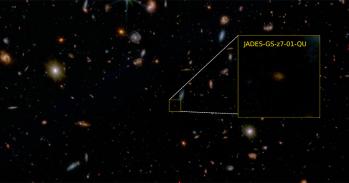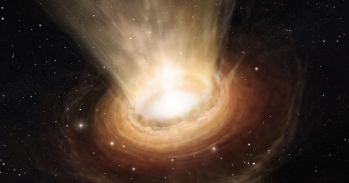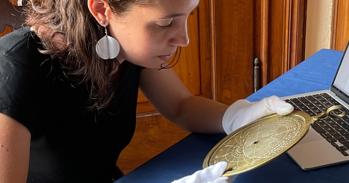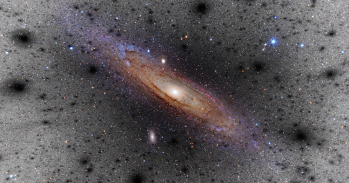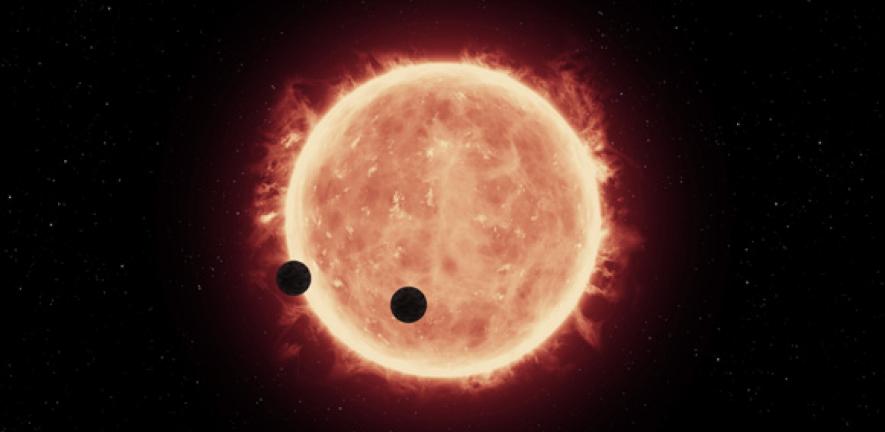
Two Earth-sized exoplanets have become the first rocky worlds to have their atmospheres studied using the Hubble Space Telescope.
Two Earth-sized exoplanets have become the first rocky worlds to have their atmospheres studied using the Hubble Space Telescope.
Humanity’s remote exploration of alien environments has truly started.
Amaury Triaud
Embarking on the first attempt at detecting the atmospheres of planets outside our solar system, a team of Cambridge and international researchers discovered that the exoplanets TRAPPIST-1b and TRAPPIST-1c, approximately 40 light-years away, are unlikely to have puffy, hydrogen-dominated atmospheres such as those usually found on gaseous worlds like Jupiter or Saturn.
The lack of a hydrogen-helium envelope increases the Earth-likeliness of these planets and has caused considerable excitement among researchers taking part in the study. The results of their findings are published today in the journal Nature.
“Humanity’s remote exploration of alien environments has truly started,” said Amaury Triaud, a research fellow at Cambridge’s Institute of Astronomy. “It is tantalizing to think that with another ten similar observations, we would start distinguishing whether those planets are more Venus-like, more Earth-like, or if they are radically different.”
Researchers observed the planets in near-infrared light and used spectroscopy to decode a change of light as the planets transited in front of their stars. During transit, starlight shines through a planet’s atmosphere making it possible to deduce its chemical makeup.
Both planets orbit TRAPPIST-1 – an ultracool dwarf star that is much cooler and redder than the sun, and barely larger than Jupiter. TRAPPIST-1 has a mass 8% that of the Sun and is located in the constellation of Aquarius. The planets orbiting the star were discovered in late 2015 through a series of observations by the TRAnsiting Planets and PlanetesImals Small Telescope (TRAPPIST), a Belgian robotic telescope located at ESO’s (European Southern Observatory’s) La Silla Observatory in Chile. The small size of the star TRAPPIST-1 boosts the signal produced by the planets’ atmospheres, easing their study by nearly 100 times compared to similar planets orbiting stars like the Sun.
TRAPPIST-1b completes a circuit around its red dwarf star in 1.5 days and TRAPPIST-1c in 2.4 days. Thanks to the faintness of the star they orbit, and to the planet’s short orbits, it is possible that parts of their surfaces have temperatures similar to the Earth. While it remains unclear whether the planets are habitable, they are the first worlds for which we can determine the existence of a habitable climate.
On May 4, astronomers took advantage of a rare simultaneous transit, when both planets crossed the face of their star within minutes of each other, to measure starlight as it filtered through any existing atmosphere. This double transit, which occurs only once every two years, provided a chance to hasten the atmospheric study of TRAPPIST-1b and TRAPPIST-1c.
The researchers now hope to use Hubble to conduct follow-up observations to search for thinner atmospheres, composed of elements heavier than hydrogen, like those of Earth and Venus.
Observations from future telescopes, including NASA’s James Webb Space Telescope, will help determine the full composition of these atmospheres and hunt for potential biosignatures, such as carbon dioxide and ozone, in addition to water vapor and methane. Webb also will analyze a planet’s temperature and surface pressure – key factors in assessing its habitability.
“Our observations demonstrate that Hubble has the capacity to play a central role,” said lead researcher Julien de Wit, of the Massachusetts Institute of Technology. “It can carry-out an atmospheric pre-screening, to tell astronomers which of these Earth-sized planets are prime candidates for more detailed study with the Webb telescope.”
The TRAPPIST telescope identified these two Earth-sized worlds during a prototype run for a more ambitious venture, called SPECULOOS, which is currently in construction at Cerro Paranal, Chile. SPECULOOS will monitor 1,000 nearby red dwarf stars seeking additional Earth-sized worlds.
Professor Didier Queloz, Professor of Physics at the Cavendish Laboratory, and a founding member of the project, said: “Within the next five years, SPECULOOS will likely detect 20-30 new Earth-sized planets. All of them will have atmospheres that can be investigated by the James Webb.”
Dr Brice-Olivier Demory, a senior research associate at the Cavendish Laboratory, said: “Soon we will have the right targets, and the right telescopes to start investigating rocky planet atmospheres beyond our Solar system. Finding out whether other worlds are indeed Earth-like is only a matter of time.”
The Hubble Space Telescope is a project of international cooperation between NASA and ESA. Goddard manages the telescope and STScI conducts Hubble science operations. STScI is operated for NASA by the Association of Universities for Research in Astronomy in Washington.

The text in this work is licensed under a Creative Commons Attribution 4.0 International License. For image use please see separate credits above.

